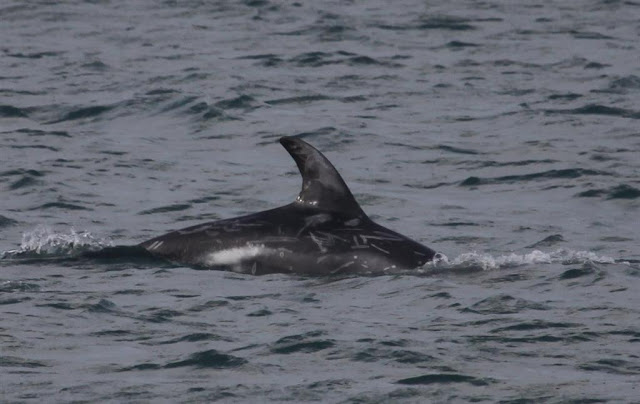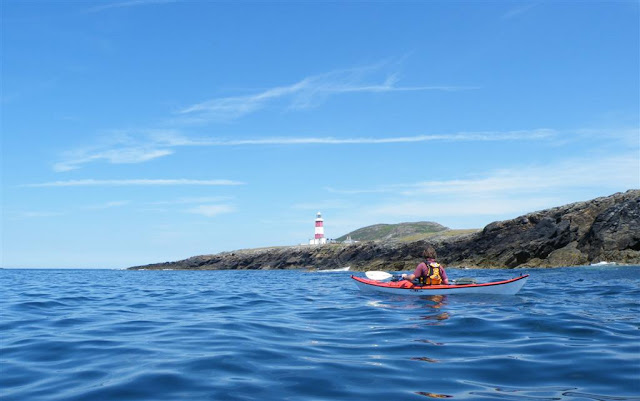Another quiet period bird-wise on Bardsey with a few Swifts passing over and a couple of Common Sandpipers frequenting the coast. But we've been treated to a gloriously sunny, calm spell and the lack of wind has resulted in an incredibly flat sea, perfect for searching for cetaceans.
Up to 23 Risso's Dolphins have been feeding just off the West Coast! The tall dorsal fin and blunt forehead makes this species easily identifiable from a distance (top). The calves are born grey, but turn darker as they age to juveniles and as they become adults their skin tone becomes more silvery. White scars cover the skin of all adult Risso's (middle); these are caused by gregarious and rough social interaction with other adults and from squid which, along with octopus and cuttle fish, are the main prey items for this species. While this particular pod had clearly found a good food source (the group was often spread out in a long line, a formation typically adopted when hunting), Risso's Dolphins prefer to feed at night when their prey items migrate closer to the surface of the water. Having said this they are able to dive to depths in excess of 1000 metres. (c) Richard Brown
The Bardsey Sound, the area of sea that stretches from the Llyn Peninsula on the mainland to Bardsey Island, has earned a fearsome reputation over the years, with no less than 45 recorded ship-wrecks between 1812 and 1914. Vessels carrying wine from Spain, china clay from Cornwall and slate from Portmadoc, to name but a few, all fell victim to these treacherous waters. Rich got the opportunity to brave these unforgiving seas in a kayak.
The waves were immense mountains, the currents unbelievably strong and the floating debris of previous wrecks had to be skilfully avoided. Luckily Rich's experience and skill took him safely through conditions that few kayakers would be equipped to deal with! Many thanks to Kev for recording the perilous journey for future generations to marvel at.
Giselle has her eye in for spotting recently emerged moths at the moment. The wings of moths are clearly not visible on the caterpillars, but they are present as tiny 'wing discs' in the second and third segments of the body. These develop within the body of the caterpillar until they are forced outside of the skin close to pupation. Within the pupa the wings develop and form a structure which is cleverly pleated in a way so that the wings can be rapidly unfolded when the adult hatches. Speed is very important just after hatching as the moths are very vulnerable to predators at this time. The Lackey (above) and Dark Arches (below) were both found at this vulnerable moment. The wings are pumped up through the veins and will dry in a couple of hours from when the moths will be capable of flight. (c) Richard Brown
A further five broods of Swallows were ringed and another pair had built a new nest at the Lighthouse. (c) Richard Brown









No comments:
Post a Comment